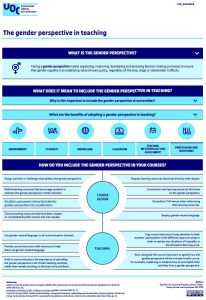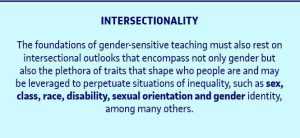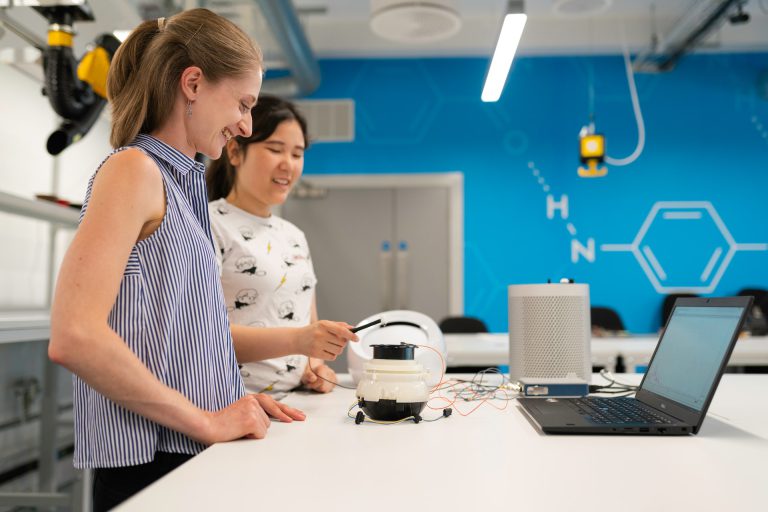Teaching with a gender perspective: an intersectional approach
8 April, 2022 Photo by Christin Hume on Unsplash
Photo by Christin Hume on UnsplashGender-sensitive teaching must be based on an intersectional approach that takes into account the many characteristics involved in the construction of people’s identities and in influencing the inequalities they experience
The #JornadaGenderUOC conference, which focused on university teaching with a gender perspective, was held on 10 March. I was invited to take part as a member of the eLearning Innovation Center’s (eLinC) Learning Design Advisory (LDA) team.
What does ‘teaching with a gender perspective’ mean?
The most noteworthy aspect that arose when reflecting about what is meant by the gender or feminist perspective is that it is not a closed definition and that the inclusion or highlighting of women in the various aspects of teaching should be carried out with a broader and intersectional approach (taking into account not just gender but also social class, ethnicity, sexual orientation and age, etc.).
To do this, the LDA team created an infographic – Docència amb perspectiva de gènere [Teaching with a gender perspective] (UOC, 2019) – together with Maria Olivella, from the UOC’s Equality Unit, and Francesc Núñez, from the UOC’s Faculty of Arts and Humanities. The proposal is to apply this broad and intersectional approach in an interdisciplinary way to the different aspects involved in designing courses at the UOC.

In our opinion, although the use of non-sexist language or highlighting the role of women in the activities proposed may be one way to start the change process, the implementation of the gender perspective must go beyond this. It must also be taken into account when selecting resources for each course, and in proposals for activities that invite reflection about cases in which gender (but also social class, ethnicity and so on) leads to inequality – including the gender perspective gives rise to new possibilities. Likewise, the assessment criteria also need to cover it, bearing in mind that proposals take these inequalities into account or suggest inclusive solutions.

The application of the gender perspective in teaching must go further and be implemented in a structural and organizational way, taking into account the horizontal and vertical segregation of academic and management responsibilities, the difficulties involved in recognizing expert female leadership, the undervaluation of female-dominated or gender studies-related research areas, and so on.1 We must also define work processes that take into account the contexts and burdens of the people who carry them out, as well as the demand to be met and their intended ultimate goal.
How can we incorporate the gender perspective in online teaching at the UOC?
In 2019, the eLinC’s2 LDA team was tasked with helping design a training course to implement the interdisciplinary competency in Global Ethical Commitment, taking the Sustainable Development Goals (SDGs) and the gender perspective into account. Since then, the eLinC has been involved in this and other initiatives to help meet the Catalan University Quality Assurance Agency’s (AQU)3 requirement to include the gender perspective throughout the University portfolio and other internal objectives for teaching set in the UOC’s Equality Plan.
During the panel discussion on “How can we incorporate the gender perspective in online teaching at the UOC?” at the conference, I presented both the actions already carried out by the eLinC and those in which we are currently involved:
01. Training Course TGP 101. Global Ethical Commitment [20192 – ongoing]
This is a training course aimed at all teaching staff members responsible for a course at the UOC designed by me and Francesc Núñez, from the Faculty of Arts and Humanities. It has been validated by the representatives of the interdisciplinary competencies working group.
It was when designing this training course that the infographic above, among other specific resources, was created.
There have been four editions to date, with 186 teaching staff members (92% of those called to take part) completing the training. We are already working on the 5th edition.
It was given an average rating of between 4 and 4.1 out of 5. And, in terms of impact, the intention to implement the gender perspective was 4.4.
02. Niu-challenge advice [Nov. 2019 – ongoing]
In November 2019, support to incorporate the gender perspective was included as one of the aspects in the advice provided in Niu-challenge courses.
Since November 2019, a total of 1,069 courses have undergone the advice process, which is still ongoing. These courses will be rolled out between the first semester of the academic year 2020/2021 and the first semester of the academic year 2022/2023.
03. Tool to ensure the inclusion of the gender perspective when designing courses [ongoing]
The incorporation of the gender perspective in teaching at the UOC requires taking into account the teaching staff’s backgrounds, and making good use of training and the outcome of the team work carried out in the advice processes.
With the aim of ascertaining the degree to which the gender perspective has been implemented in the UOC’s portfolio and highlighting any possible actions that could be carried out to include it when designing courses, the following action has been included in the strand of the Equality Plan covering teaching: 1.1.1 Design a tool to verify whether the gender perspective criterion is being met in course design.
This action is led by the eLinC, and people from throughout the UOC are participating. The teaching staff involved have a key role when it comes to validating each of the decisions proposed.
04. Set of specific resources in the eLearning Kit [20192 – ongoing]
The aim of the eLearning Kit is to provide teaching staff with all the resources they might need to design courses. It has a specific section on the gender perspective where they can find resources created by the LDA team, as well as resources from other UOC and external teams.
What now?
The feedback we got at the end of the conference from attendees was positive. They were satisfied with the time and the space we’d shared. They also mentioned the desire or the need for new settings for sharing and reflecting on these issues.
Here at the eLinC, we’ve seen that not all decisions relating to designing with a gender perspective are always readily observable. This is why we believe it is also important to continue working on obtaining and sharing proposals that include less obvious decisions or decisions that address specific aspects of each area.
We need to create spaces for sharing the difficulties we face, and for sharing our success stories, too.
This article is part of the UOC’s commitment to achieving United Nations Sustainable Development Goal (SDG) 4, Quality Education and 5, Gender Equality.
1Equality Unit; Learning Processes (eLearning Innovation Center); Faculty of Arts and Humanities. Docència amb perspectiva de gènere [online document]. Barcelona: Universitat Oberta de Catalunya, 2019. [Accessed: 4 October 2021].Available at: http://materials.cv.uoc.edu/cdocent/PID_00272060/
2At the time, it was known as the eLearn Center’s Learning Processes team.
3Formerly, eLC Kit
References:
Equality Unit; Learning Processes (eLearning Innovation Center); Faculty of Arts and Humanities. Docència amb perspectiva de gènere [online document]. Barcelona: Universitat Oberta de Catalunya, 2019 [accessed: 28 March 2022].Available at: http://materials.cv.uoc.edu/cdocent/PID_00272060/






